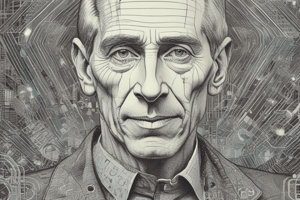Podcast
Questions and Answers
What does high entropy signify?
What does high entropy signify?
- Low predictability
- High uncertainty (correct)
- High certainty
- Predictable outcomes
How does entropy change when flipping a fair coin?
How does entropy change when flipping a fair coin?
- Moderate entropy (correct)
- Low entropy
- Unpredictable entropy
- High entropy
Which of the following is an application of information theory mentioned in the text?
Which of the following is an application of information theory mentioned in the text?
- Data Compression (correct)
- Cooking recipes
- Predicting weather patterns
- Vehicle maintenance
What role do Error Correction Codes play in modern technologies?
What role do Error Correction Codes play in modern technologies?
How does information theory contribute to wireless communications?
How does information theory contribute to wireless communications?
What did Shannon's theories focus on?
What did Shannon's theories focus on?
What is the core concept of Shannon's Information Theory?
What is the core concept of Shannon's Information Theory?
Which process in Shannon's Information Theory converts messages to a standardized representation like binary code?
Which process in Shannon's Information Theory converts messages to a standardized representation like binary code?
What is the role of Channel Encoding in Shannon's Information Theory?
What is the role of Channel Encoding in Shannon's Information Theory?
In information theory, what does Entropy describe?
In information theory, what does Entropy describe?
What was the primary goal of Shannon's Information Theory?
What was the primary goal of Shannon's Information Theory?
How does Source Encoding contribute to efficient communication according to Shannon's Information Theory?
How does Source Encoding contribute to efficient communication according to Shannon's Information Theory?
Study Notes
Information Theory and Coding: Understanding Shannon's Foundations
At the heart of modern communications technology lies information theory — a field pioneered by Claude E. Shannon with his groundbreaking work in the late 1940s. In this exploration, we delve into Shannon's foundational contributions, particularly Shannon's Information Theory and its core concept, Entropy, while avoiding jargon and framing our insights within real-world applications.
Shannon's Information Theory
This cornerstone theory centers around quantifying how effectively messages can be communicated over channels like telegraph wires, radio waves, or even human conversation. It operates under two fundamental principles:
- Source Encoding: This process converts messages from their original form to a standardized representation, such as binary code, making transmission more efficient.
- Channel Encoding: By appending additional data called redundant bits, noise is counteracted during transmission, ensuring message integrity upon reception.
The goal of Shannon's theory was to mathematically define the limits of reliable communication, enabling engineers to design systems capable of conveyance without error.
Entropy
A crucial element integral to understanding information theory is entropy. This term describes the amount of uncertainty inherent in a source of information. Mathematically expressed, entropy represents the expected value of the natural logarithm of probabilities associated with each possible outcome. High entropy corresponds to high uncertainty; conversely, low entropy implies predictable outcomes. For instance, when flipping a fair coin, there are only two potential results—heads or tails—resulting in moderate entropy. Yet when selecting a random number between one and ten, the vast array of possibilities significantly increases the system's entropy level.
Applications of Information Theory and Coding
Modern technologies rely heavily on the concepts developed through information theory and coding. A few notable examples include:
- Data Compression: By eliminating redundancy, data compression techniques reduce file sizes, resulting in quicker transmissions and storage capabilities.
- Error Correction Codes: These schemes enable accurate recovery from errors introduced during transmissions across unreliable channels.
- Cryptography: Information security relies on information theory and coding methods for encryption algorithms and secure data exchanges.
- Wireless Communications: From WiFi signals to cellular networks, the application of information theory helps ensure efficiency and reliability at every stage of transfer.
In summary, Shannon's revolutionary theories have transformed the landscape of communication technologies. His focus on quantifiable measures made it possible to implement fundamental changes to how we transmit, store, and protect information today. As you continue your study, keep these central ideas in mind and explore new avenues where information theory makes a difference.
Studying That Suits You
Use AI to generate personalized quizzes and flashcards to suit your learning preferences.
Description
Delve into Claude E. Shannon's groundbreaking work in information theory, focusing on concepts like entropy, source encoding, and channel encoding. Explore real-world applications of Shannon's foundational contributions to communication technologies.




